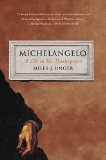Summary | Excerpt | Reviews | Beyond the Book | Readalikes | Genres & Themes | Author Bio

Critics' Opinion:
Readers' Opinion:
First Published:
Jul 2014, 448 pages
Paperback:
Jul 2015, 448 pages
 Book Reviewed by:
Book Reviewed by:
Suzanne Reeder
Buy This Book
Even in an age of towering giants, Michelangelo was the first artist to be the subject of a cult of personality. His character was as much a matter for public speculation as the meaning of the works he created, and it was impossible to understand the one without the insight provided by the other. It has become a cliché to say that an artist must express himself in his work, but this commonplace was largely Michelangelo's invention. To be an artist in the new sense of the word, it was not sufficient to possess supreme skill. Skill was only the means to an end, which was to make the work embody the self.
This explains why the private lives of his great rivals—Leonardo, Raphael, and Titian, to name only the most prominent—were never subject to the same kind of scrutiny that routinely followed Michelangelo. Most focused on his eccentricities, his preference for solitude, his melancholy, his ill temper. Even his personal hygiene became a matter of public comment. "[W]hile a man of so great genius," an early chronicler observed, "he was by nature so coarse and wild as to inform his domestic life with an incredible shabbiness."
But rather than diminish his reputation, these observations merely heightened Michelangelo's mystique. Michelangelo was the first truly modern artist, emancipated not only from a slavish subservience to his patrons but from social norms altogether. His brooding temperament and contempt for social norms was a crucial aspect of a mythologizing that began in his own lifetime. As a youth, recalled Condivi, "he almost withdrew from the fellowship of men, only consorting with a few. So that by some he was held to be proud, and by others odd and eccentric . . . company not only did not please him but even annoyed him, as interrupting his meditations; he was never less solitary than when alone."
Because his contemporaries were fascinated with details of his private life, Michelangelo, even after the passage of five centuries, comes across as a fully formed human being: driven, passionate, mercurial, irascible, devoted to his few close friends but also quick to accuse them of betrayal. He could inspire fierce loyalty, but also an intense aversion, particularly among those who felt the bite of his anger or the sting of his ridicule. To some of his employees he acted like an indulgent father, nursing them when they were sick or providing generously for their families after they died. But he could also treat his underlings harshly, dismissing them for minor offenses and then publicizing their faults so they had difficulty finding any other work. He was generous to those he considered the deserving poor, but his tendency to pocket his commissions and then fail to deliver what he?'d promised led to charges of greed and even outright fraud.
Even so, one must be careful not to accept everything at face value. Both he and his allies recognized that even a "warts-and-all" depiction could work to his advantage. In flouting norms he merely confirmed his originality, and it was originality that distinguished the true artist from the humble craftsman, the creative genius from the hack. Who's ever heard of a tormented carpenter? Or a mercurial glass blower? Of course, these skilled trades have their share of neurotics, but no one believes it's part of the job description.
Michelangelo, by contrast, deliberately broke down the barriers between life and art, setting up a paradigm—most fully embraced by the Romantic movement in the nineteenth century—in which suffering is regarded as the basis of creativity. In his poetry, Michelangelo lays bare his troubles, his vaunting pride and crippling doubt, the exaltation of desire and the crushing burden of shame. "I live to sin," he despaired in an unfinished madrigal,
for the soul that living dies,
my life being no more mine,
but to wickedness enslaved.
Works like the famous Captives or the late pietàs are almost equally confessional. Even when the artist does not appear onstage, we can feel him lurking in the background, dominating the action through the force of his will.
Excerpted from Michelangelo by Miles J Unger. Copyright © 2014 by Miles J Unger. Excerpted by permission of Simon & Schuster. All rights reserved. No part of this excerpt may be reproduced or reprinted without permission in writing from the publisher.





The House on Biscayne Bay
by Chanel Cleeton
As death stalks a gothic mansion in Miami, the lives of two women intertwine as the past and present collide.

The Flower Sisters
by Michelle Collins Anderson
From the new Fannie Flagg of the Ozarks, a richly-woven story of family, forgiveness, and reinvention.

The Funeral Cryer by Wenyan Lu
Debut novelist Wenyan Lu brings us this witty yet profound story about one woman's midlife reawakening in contemporary rural China.
Your guide toexceptional books
BookBrowse seeks out and recommends the best in contemporary fiction and nonfiction—books that not only engage and entertain but also deepen our understanding of ourselves and the world around us.